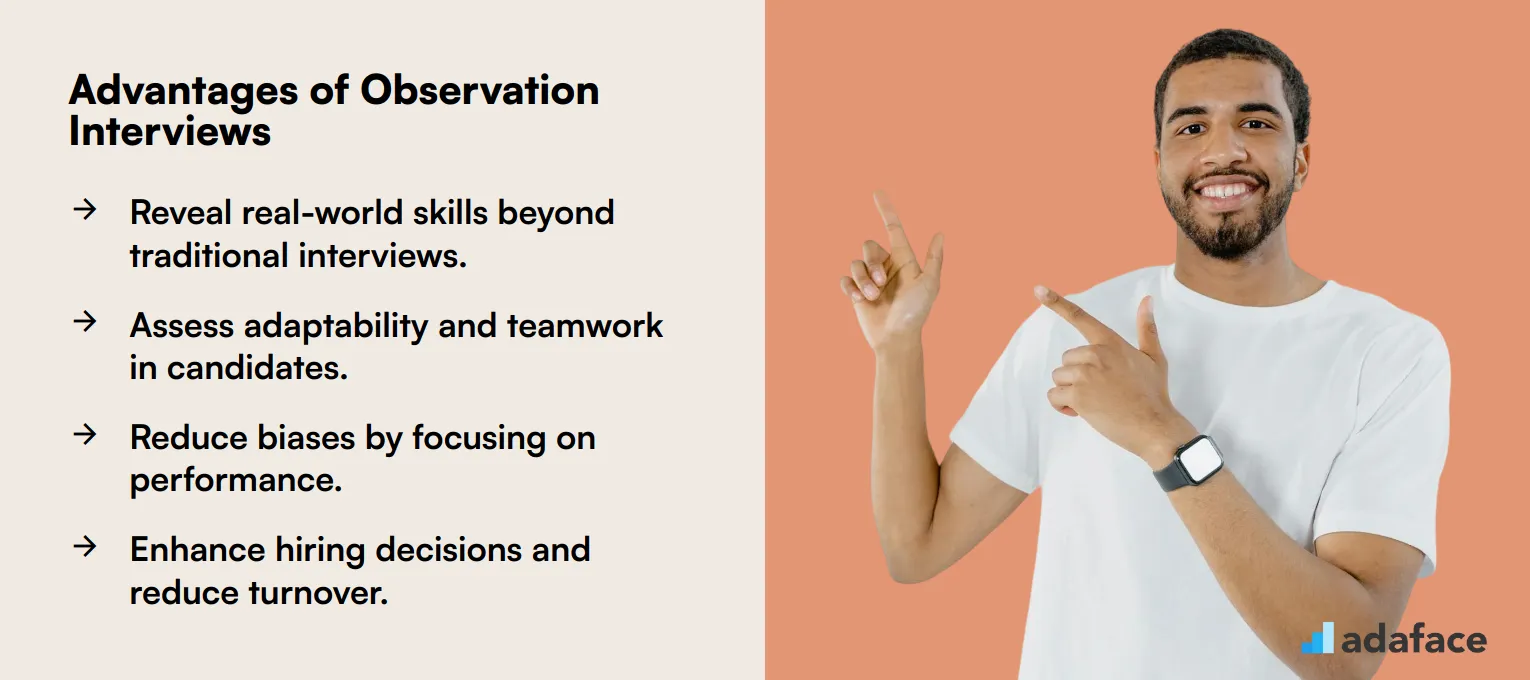Observation interviews offer recruiters a unique way to assess candidates in action. This method allows you to evaluate skills and behaviors directly in a work-like environment.
By observing candidates perform tasks, recruiters gain insights that traditional interviews might miss. This guide will help you understand and implement observation interviews effectively in your recruitment process.
Table of contents
What is an observation interview?
An observation interview is a unique method where the interviewer observes the candidate in a real or simulated work environment. Unlike traditional interviews, this approach provides insights into how candidates interact with their surroundings and handle tasks.
This type of interview allows recruiters to assess skills and behaviors that may not be evident in a standard interview setting. By watching candidates in action, interviewers can evaluate attributes like teamwork, problem-solving, and adaptability.
Observation interviews can be particularly useful for roles that require specific behavioral competencies. For instance, seeing how a candidate manages stress in a high-pressure situation can be more telling than discussing it.
This approach also helps in identifying potential red flags that might not surface in a typical interview. It provides a more holistic view of the candidate's abilities, making it a valuable tool in the recruitment process.
While observation interviews can be resource-intensive, they offer a deeper understanding of a candidate's fit for the role. This method is often used in industries where hands-on skills are critical, ensuring that the right candidate is selected for the job.
Key elements of an observation interview
Observation interviews are a powerful tool in the recruitment process. They involve watching candidates perform job-related tasks in a simulated or real work environment.
The key elements of an observation interview include:
- Setting up a realistic work scenario
- Defining clear evaluation criteria
- Observing candidate behavior and performance
- Taking detailed notes
- Providing a consistent experience for all candidates
Preparing a suitable environment is crucial for an effective observation interview. This could be a mock workspace or an actual area where the job is typically performed.
Clearly defined evaluation criteria help ensure objectivity and fairness. These criteria should align with the essential skills and competencies required for the role.
During the interview, observers should focus on the candidate's actions, decision-making processes, and problem-solving approaches. It's important to maintain a non-intrusive presence to allow candidates to perform naturally.
Detailed note-taking is essential for accurate assessment and comparison. Observers should record specific behaviors, actions, and outcomes related to the predefined criteria.
Consistency across all candidate interviews is vital for fair evaluation. This includes using the same scenario, time allocation, and evaluation criteria for each candidate.
How to conduct an effective observation interview
Conducting an effective observation interview requires careful planning and execution. Start by clearly defining your objectives and the specific behaviors or skills you want to observe during the interview process.
Create a structured observation checklist to ensure consistency across all candidates. This checklist should include key performance indicators and behavioral traits relevant to the role you're hiring for.
Choose an appropriate setting that closely mimics the actual work environment. This could be a simulated workspace or a real-life scenario where candidates can demonstrate their skills and problem-solving abilities.
Brief the candidates thoroughly on what to expect during the observation interview. Provide clear instructions and any necessary materials or tools they might need to complete the assigned tasks.
During the interview, maintain a neutral presence and avoid interfering with the candidate's performance. Take detailed notes on their actions, decisions, and overall approach to the tasks at hand.
After the observation, conduct a brief follow-up discussion with the candidate. This allows you to gain insights into their thought processes and gives them an opportunity to explain their actions or decisions.
Benefits of observation interviews in recruitment
Observation interviews offer several advantages in the recruitment process, enhancing the overall evaluation of candidates. They allow recruiters to see how candidates perform in real-world scenarios, providing insights beyond what traditional interviews can capture. This method uncovers soft skills like problem-solving and communication, which are important in the workplace. By observing candidates in action, interviewers can assess their adaptability and teamwork, crucial traits for dynamic work environments. Observation interviews also help reduce biases by focusing on actual performance rather than assumptions based on resumes. This approach leads to more informed hiring decisions, ultimately improving the quality of hire and reducing turnover rates.

Common challenges and how to overcome them
Observation interviews can present several challenges, but understanding these can help you navigate them effectively. One common issue is interviewer bias, where personal opinions or stereotypes influence the evaluation of a candidate. To combat this, use structured interviews, which provide a consistent framework for assessing all candidates fairly.
Another challenge is the potential for misinterpretation of non-verbal cues, which can lead to incorrect assumptions about a candidate's suitability. Training interviewers to accurately interpret body language and facial expressions can mitigate this risk. Additionally, incorporating behavioral questions can provide a clearer picture of a candidate's skills and experiences.
Time constraints can also pose a problem, as they may lead to rushed assessments and overlooked details. Allocating adequate time for each interview and using efficient recruitment tools can ensure a thorough evaluation process. Lastly, technical difficulties during virtual interviews can disrupt the flow and affect the candidate's performance.
To overcome this, ensure all technology is tested beforehand and have a backup plan in place. By addressing these challenges proactively, you can enhance the effectiveness of observation interviews and make more informed hiring decisions.
Best practices for documenting observation interviews
Documenting observation interviews is an important part of the recruitment process. It ensures that all the insights gathered during the interview are accurately captured and can be referred to when making hiring decisions.
Start by preparing a structured template that includes sections for key observations, candidate strengths, and areas for improvement. This will help you maintain consistency across interviews and ensure no critical information is overlooked.
During the interview, take concise notes to capture the candidate's responses and behaviors. Avoid relying solely on memory, as this can lead to biases or omissions, impacting your hiring decision.
After the interview, review and expand on your notes while the details are still fresh in your mind. This is also a good time to compare your observations with any pre-established criteria or job requirements.
Finally, ensure that your documentation is securely stored, easily accessible, and shared with relevant team members. This promotes transparency and collaboration in the recruitment process, allowing for more informed and balanced hiring decisions.
Conclusion
Observation interviews offer a unique way to assess candidates in their natural work environment. By watching candidates perform tasks, interviewers can gain insights that traditional interviews might miss.
Implementing observation interviews requires careful planning and execution. Follow the best practices outlined in this guide to make the most of this valuable recruitment tool.
Remember, observation interviews are just one part of a comprehensive hiring process. Combine them with other interview types and assessments for a well-rounded evaluation of candidates.
Observation Interview FAQs
- Provides real-time assessment of skills
- Reveals candidate behavior in work-like situations
- Offers insights into problem-solving approaches
- Helps evaluate cultural fit more accurately
An effective observation interview typically lasts 1-2 hours. This duration allows enough time to observe the candidate performing relevant tasks and interacting with others. Adjust the length based on the complexity of the role and tasks being observed.
Observation interviews are particularly useful for:
- Customer-facing roles (sales, customer service)
- Technical positions (software development, IT)
- Creative roles (design, marketing)
- Leadership positions (team management, project coordination)
- Use standardized tasks for all candidates
- Train observers to recognize and avoid bias
- Use structured evaluation criteria
- Combine observation with other assessment methods
- Provide equal preparation information to all candidates
- Time-consuming nature of the process
- Difficulty in creating realistic scenarios
- Potential for observer bias
- Candidates feeling uncomfortable or pressured
- Ensuring consistency across different observers

40 min skill tests.
No trick questions.
Accurate shortlisting.
We make it easy for you to find the best candidates in your pipeline with a 40 min skills test.
Try for freeRelated terms



